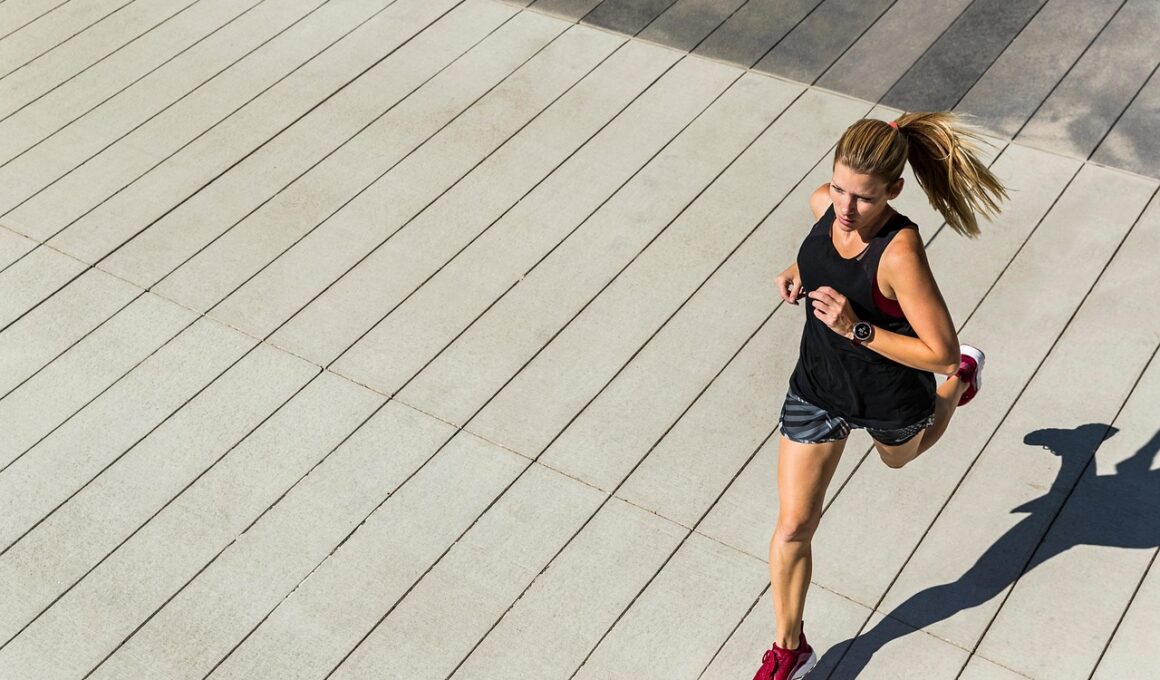Improving Hip Flexor Mobility Through Targeted Stretches
In the world of running and jogging, maintaining optimal flexibility is essential for performance and injury prevention. One crucial area often neglected is the hip flexors. These muscles, which connect the pelvis to the thighs, play a significant role in running efficiently. Tight hip flexors can lead to problems such as reduced stride length, pain in the lower back, and a host of other issues that could sideline runners. By incorporating targeted stretches, runners can improve mobility and enhance their overall running experience. The following sections will explore specific stretches and techniques that focus on enhancing hip flexor mobility. Maintaining a balanced routine that integrates these stretches into your training can yield significant results, allowing for more fluid motion and reduced discomfort. Remember that warming up before stretching is crucial to prevent injuries. Now, let’s delve into some effective stretches that you can add to your workout regimen. Striking the right balance in your training plan can be beneficial for both performance and recovery.
One effective stretch for improving hip flexor mobility is the kneeling hip flexor stretch. To perform it, start by kneeling on one knee with the other foot flat on the ground in front of you, forming a 90-degree angle. This position allows you to feel the stretch deep in the hip of the kneeling leg. Gently push your hips forward while keeping your back straight. Hold this position for about 30 seconds, ensuring to breathe deeply as you hold the stretch. Switch legs and repeat the process on the other side. This stretch specifically targets the psoas and iliacus muscles, which are central components of the hip flexor group. To increase the intensity of the stretch, consider raising the arm on the same side as your kneeling leg toward the ceiling, creating an even greater stretch through the front of the hip. Consistency with this stretch can lead to gradual improvements in mobility over time. Keeping the body well-aligned during your stretches can further enhance their effectiveness, making it crucial to pay attention to form.
Dynamic Stretches for Runners
An alternative to static stretching is dynamic stretching, which involves movement and can be very beneficial before a run. One popular dynamic stretch for the hip flexors is the walking lunge. To perform this stretch, step forward with your right foot into a lunge position, ensuring your knee stays above your ankle. Lower your hips until you feel a comfortable stretch in the hip flexors of the back leg. Then, push through your front heel and step your back foot forward into the next lunge. Continue alternating legs for several repetitions. Dynamic stretching warms up the muscles, increases blood flow, and prepares the body for more vigorous activity. This can be particularly advantageous for runners as it mimics the movements performed during running. In addition, incorporating arm movements into your lunges can enhance the stretch, promoting better coordination and balance. It’s important to maintain a controlled pace while performing dynamic stretches to prevent any abrupt movements that may lead to injury.
Another excellent stretch for hip flexor mobility is the frog stretch. This stretch is particularly effective for targeting the inner thighs and groin, which play a supportive role in hip motion. Start on your hands and knees, then slowly spread your knees apart while keeping your feet in line with your knees, resembling a frog position. Gradually lower your torso towards the ground, feeling the stretch in your hips. Hold this position for around 30 seconds while breathing deeply to help relax your body. You can gently rock back and forth to intensify the stretch and increase flexibility further. This stretch can also facilitate improved hip mobility, benefiting your running stride significantly. Remember to engage your core while holding the position to maintain stability and avoid unnecessary strain. It’s crucial to ensure that you are listening to your body during this stretch; if any pain occurs, ease up on the stretch. Incorporating the frog stretch into your warm-up routine can prepare your body for effective running sessions by enhancing overall mobility.
Strengthening the Hip Flexors
In addition to stretching, incorporating strengthening exercises for the hip flexors is vital for overall mobility and functionality. One particularly effective exercise is the standing knee lift. To perform this movement, stand on one leg while lifting the opposite knee towards your chest, keeping your back straight and core engaged. Hold for a moment, then lower the knee back down without letting it touch the floor. Repeat this exercise for several repetitions on each leg. Strengthening the hip flexor muscles can improve running performance as it enhances your ability to lift your legs during movement. A strong core is crucial for optimal hip flexor function, so consider adding various core strengthening exercises into your routine, such as planks and bridges. A combination of stretching and strengthening will allow you to achieve greater flexibility and endurance, ultimately improving running efficiency. As the hip flexors strengthen, they will also adapt better to the rigors of running, reducing the risk of injury. Regularly practicing these exercises will yield positive results.
Recovery is an essential aspect of any training program, and hip flexor mobility should be prioritized to help facilitate this process. Foam rolling can be an effective method for releasing tension in the hip flexor area. Utilizing a foam roller, you can apply pressure to the hip flexors, alleviating tightness and soreness. Spend about 1-2 minutes rolling over the area while focusing on any knots or tight spots. This self-myofascial release enhances blood flow to the muscles and prepares them for recovery. Additionally, consider integrating yoga into your routine to improve flexibility and reduce tension in the hip area. Poses like pigeon pose and butterfly stretch can work wonders for hip mobility. Combining foam rolling with yoga methods can create a balanced approach to recovery, helping you to maintain optimal hip flexor health. Be sure to focus on controlled movements and breath during yoga practices. Consistent recovery practices will help keep your hip flexors flexible, strong, and ready for your next running session.
Conclusion: Enhancing Overall Mobility
In conclusion, improving hip flexor mobility through targeted stretches is vital for any runner striving to enhance performance and reduce the risk of injury. Incorporating a combination of static and dynamic stretches, along with appropriate strengthening exercises, works synergistically to prepare the body for running. Remember to focus on proper form while doing each stretching or strengthening exercise to maximize the benefits and minimize the risk of injury. Additionally, incorporating recovery methods such as foam rolling and yoga can further support mobility in the hip flexors. Followers of any good training program will find that keeping these areas well-maintained leads to better overall running experiences. Whether you are a seasoned runner or just starting out, giving attention to hip flexor mobility can lead to significant improvements in stride efficiency and comfort during runs. Consistency is key, so be sure to embed these practices into your regular training regimen. A well-rounded approach to flexibility and strength in your hips will not only enhance your performance but also contribute to prolonged running enjoyment.
Ultimately, by understanding the importance of hip flexor mobility and committing to a routine that includes stretching, strengthening, and recovery, you significantly increase your potential as a runner. Assess your current flexibility and consider tracking your progress over time to see how these methods contribute to improvements in your running form. Investing time in stretching routines can translate into more enjoyable and pain-free runs while also allowing you to push your limits without fear of injury. As you develop your flexibility and strength, you will likely experience greater comfort and efficiency during your runs, leading to enhanced performance. Focus on goals around improving hip flexor mobility not just to meet immediate needs but as part of a long-term running strategy. Your hip flexors are crucial to your overall functional movement, and caring for them will benefit your entire body. With ongoing commitment, applying these techniques should yield positive results that can energize your running journey and motivate you to explore your potential further. The journey to improved hip mobility is a valuable investment into your athleticism.


